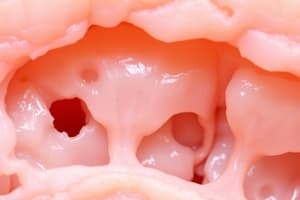Podcast
Questions and Answers
Which of the following best describes hyperplasia?
Which of the following best describes hyperplasia?
- The conversion from one type of normal adult cell to another type of normal adult cell
- The ability to cause hyperplasia by insulin-like growth factor 1 (IGF) through the splitting of cells
- The increase in the volume of an organ or tissue due to the enlargement of its component cells
- Increased cell production in a normal tissue or organ, which may produce tissue masses referred to as tumors and ceases growth at some point (correct)
Which of the following is true about hyperplasias?
Which of the following is true about hyperplasias?
- They result in the increase in the size of cells, for example, to skeletal muscle cells during weight training
- They are also known as hypertrophy and occur due to insulin-like growth factor 1 (IGF)
- They lead to the conversion from one type of normal adult cell to another type of normal adult cell
- They lack the capacity for autonomous growth and are controlled by an identifiable stimulus (correct)
What distinguishes pathologic hyperplasia from physiologic hyperplasia?
What distinguishes pathologic hyperplasia from physiologic hyperplasia?
- Pathologic hyperplasia is reversible when the stimulus is removed, while physiologic hyperplasia is irreversible
- Pathologic hyperplasia is controlled by an identifiable stimulus, while physiologic hyperplasia is initiated and controlled by an identifiable stimulus
- Pathologic hyperplasia is due to the growth of normal cells, while physiologic hyperplasia is a sign of abnormal or precancerous changes (correct)
- Pathologic hyperplasia may produce tissue masses referred to as tumors, while physiologic hyperplasia lacks the capacity for autonomous growth
What effect does insulin-like growth factor 1 (IGF) have on the human body?
What effect does insulin-like growth factor 1 (IGF) have on the human body?
What happens to hyperplasias when the identifiable stimulus is removed?
What happens to hyperplasias when the identifiable stimulus is removed?
What distinguishes a hamartoma from a choristoma?
What distinguishes a hamartoma from a choristoma?
How is a hemangioma typically treated?
How is a hemangioma typically treated?




